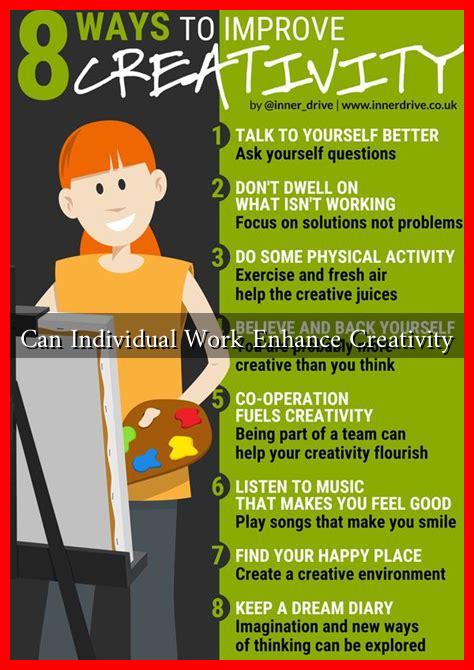-
Table of Contents
- Can Individual Work Enhance Creativity?
- The Power of Solitude
- 1. Reduced Distractions
- 2. Freedom to Explore
- Case Studies: Individual Creativity in Action
- Psychological Insights into Individual Creativity
- 3. Enhanced Self-Reflection
- Balancing Individual and Collaborative Work
- Conclusion: Embracing Individual Creativity
Can Individual Work Enhance Creativity?
Creativity is often viewed as a collaborative endeavor, with brainstorming sessions and team projects taking center stage in many workplaces. However, the role of individual work in fostering creativity is equally significant and deserves attention. This article explores how working alone can enhance creativity, supported by research, examples, and practical insights.
The Power of Solitude
Solitude has long been associated with creativity. Many renowned artists, writers, and thinkers have credited their best ideas to periods of isolation. For instance, Virginia Woolf famously wrote about the need for a “room of one’s own” to cultivate creativity. But what is it about individual work that can enhance creative output?
1. Reduced Distractions
When individuals work alone, they often experience fewer distractions compared to collaborative environments. This focused time allows for deeper thinking and exploration of ideas. Research indicates that multitasking can reduce productivity by as much as 40% (source: American Psychological Association). By minimizing interruptions, individuals can immerse themselves in their creative processes.
2. Freedom to Explore
Individual work provides the freedom to explore unconventional ideas without the fear of judgment. This autonomy can lead to innovative thinking. A study published in the journal *Creativity Research Journal* found that individuals who worked alone were more likely to generate original ideas compared to those in group settings. The absence of groupthink allows for a more diverse range of thoughts and solutions.
Case Studies: Individual Creativity in Action
Several notable figures exemplify how individual work can lead to remarkable creative achievements:
- Albert Einstein: Often worked alone, developing his theories in solitude. His theory of relativity was conceived during a period of deep personal reflection.
- Agatha Christie: The prolific author wrote many of her novels in isolation, often in a quiet room where she could focus entirely on her characters and plots.
- Steve Jobs: Known for his solitary walks, Jobs often found inspiration away from the hustle of the office, allowing his mind to wander and innovate.
Psychological Insights into Individual Creativity
Psychologists have studied the relationship between solitude and creativity extensively. One key finding is that individual work can lead to a state of “flow,” a term coined by psychologist Mihaly Csikszentmihalyi. Flow is characterized by complete immersion in an activity, leading to heightened creativity and productivity. The conditions for achieving flow are often more easily met in solitary work environments.
3. Enhanced Self-Reflection
Working alone allows for greater self-reflection, which is crucial for creative development. Individuals can assess their ideas critically and refine them without external pressure. This self-reflective practice can lead to breakthroughs in thinking and innovation.
Balancing Individual and Collaborative Work
While individual work has its advantages, it is essential to strike a balance between solitary and collaborative efforts. Both modes of working can complement each other:
- Idea Generation: Individuals can brainstorm alone and then bring their ideas to a group for feedback.
- Refinement: Collaborative teams can help refine and enhance ideas generated during individual work.
- Accountability: Working alone can foster personal accountability, while collaboration can provide motivation and support.
Conclusion: Embracing Individual Creativity
In conclusion, individual work plays a crucial role in enhancing creativity. By providing a distraction-free environment, fostering freedom of thought, and allowing for deep self-reflection, solitary work can lead to innovative ideas and solutions. While collaboration is essential in many contexts, recognizing the value of individual creativity can lead to a more balanced and effective approach to problem-solving and innovation.
As we navigate an increasingly complex world, embracing both individual and collaborative work styles will be key to unlocking our creative potential. Whether you are an artist, a scientist, or a business professional, carving out time for individual work can be a powerful catalyst for creativity.
For further reading on the relationship between solitude and creativity, consider exploring resources from the American Psychological Association.


